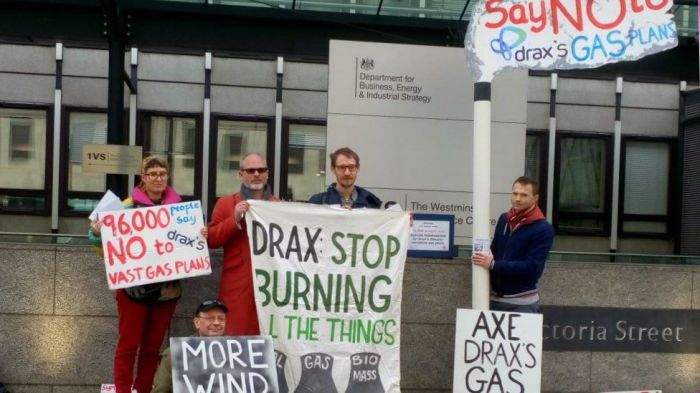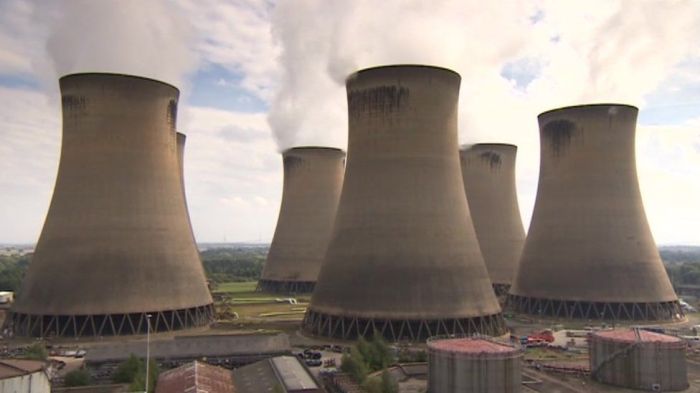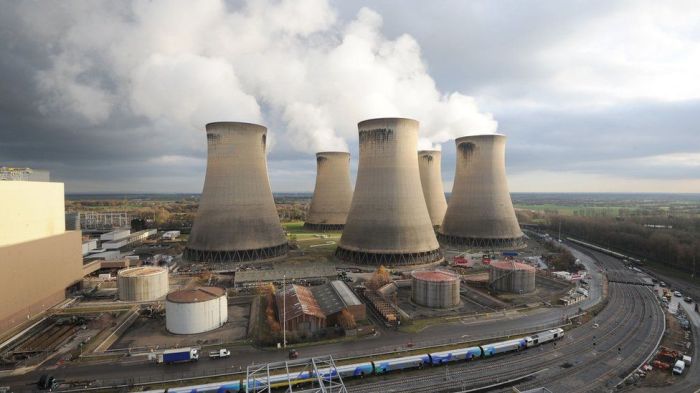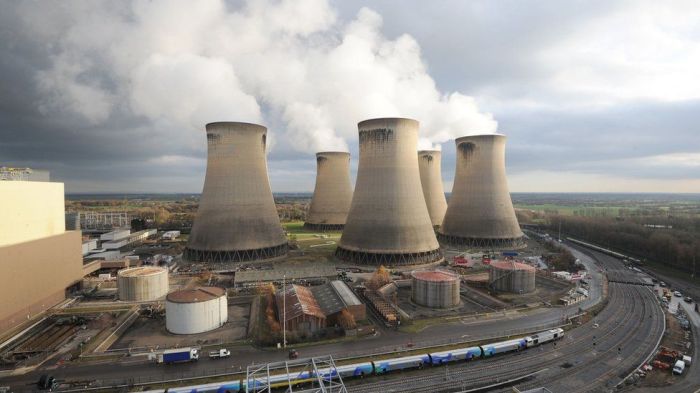Carbon capture plant Drax controversy – the phrase itself sparks a whirlwind of debate. On one side, a promising technology aimed at mitigating climate change, on the other, concerns about its effectiveness, cost, and potential environmental impact. The Drax Power Station, once a coal-fired behemoth, has transitioned to burning biomass, but the controversy surrounding its carbon capture plant remains a hot topic.
Is it a beacon of hope in the fight against climate change, or a risky gamble with unforeseen consequences?
Drax’s carbon capture plant is a complex issue with no easy answers. It promises to capture and store CO2 emissions, potentially reducing the plant’s overall carbon footprint. However, critics argue that the technology is still unproven, costly, and could have unintended environmental consequences.
This blog post dives into the heart of the debate, exploring both sides of the argument and examining the potential impact of this ambitious project.
Drax Power Station: Carbon Capture Controversy
Drax Power Station, located in North Yorkshire, England, is one of the largest power stations in the UK. It was originally built in the 1970s to generate electricity from coal. However, in recent years, Drax has transitioned to burning biomass, primarily wood pellets imported from the United States.
This shift was driven by the UK government’s Renewable Obligation scheme, which incentivizes renewable energy sources. Drax’s transition to biomass has reduced its carbon emissions compared to coal, but it remains a significant source of greenhouse gas emissions.
Carbon capture technology is a promising solution to mitigate climate change by capturing carbon dioxide (CO2) emissions from industrial processes and storing them underground. The technology works by separating CO2 from other gases in the flue gas stream of a power plant or industrial facility.
The captured CO2 is then compressed and transported to a storage site, typically a depleted oil or gas field or deep geological formations. The potential benefits of carbon capture include reducing greenhouse gas emissions, extending the lifespan of fossil fuel power plants, and creating new economic opportunities in the carbon capture and storage industry.
Drax’s Carbon Capture Plant: Controversy
In 2021, Drax announced plans to build a carbon capture plant at its power station. The project, named “Project Capture”, aims to capture up to 8 million tonnes of CO2 per year, equivalent to the emissions of 4 million cars.
This would make it one of the largest carbon capture projects in the world. However, the project has been met with controversy, with critics raising concerns about its environmental impact, economic viability, and the sustainability of biomass.
Drax’s Carbon Capture Plant
Drax Power Station, located in North Yorkshire, England, has been a controversial topic for years, particularly due to its transition from coal-fired power generation to biomass. Now, Drax is pushing further with a significant investment in carbon capture technology.
The Technology
Drax utilizes a post-combustion carbon capture technology called “amine scrubbing.” This process involves using a chemical solvent, an amine solution, to capture carbon dioxide (CO2) from the flue gases emitted by the power station’s biomass boilers.
The Operation and Capacity
The plant is designed to capture approximately 8 million tonnes of CO2 annually, which represents about two-thirds of the total CO2 emissions from the Drax power station. This captured CO2 will be transported via pipeline to be stored permanently underground in geological formations.
Environmental Impact
The carbon capture plant at Drax is expected to have a significant environmental impact, both positive and negative.
Obtain recommendations related to biggest problem tech leads how to overcome that can assist you today.
Positive Impacts
- Reduced CO2 emissions:The primary aim of the plant is to capture and store CO2, significantly reducing the power station’s greenhouse gas emissions. This contributes to mitigating climate change and meeting emission reduction targets.
- Demonstrating technology:The Drax project is a large-scale demonstration of carbon capture technology, which could pave the way for wider adoption of this technology in other industries.
- Economic benefits:The project is creating jobs and boosting the local economy, especially in the construction and engineering sectors.
Negative Impacts
- Energy consumption:The carbon capture process requires significant energy, which could lead to increased energy consumption and potentially higher electricity prices.
- Land use:The transport and storage of captured CO2 requires significant land use, which could raise concerns about the impact on biodiversity and local communities.
- Environmental risks:There are concerns about potential environmental risks associated with the transport and storage of CO2, such as leaks or spills.
Arguments for the Carbon Capture Plant

The Drax carbon capture plant has sparked a debate, with both supporters and detractors voicing their opinions. While some argue that the technology is unproven and expensive, others believe it holds the potential to significantly reduce carbon emissions and contribute to a cleaner energy future.
Let’s explore the key arguments in favor of this innovative project.
Environmental Benefits
The primary argument in favor of Drax’s carbon capture plant is its potential to significantly reduce greenhouse gas emissions. The plant aims to capture up to 95% of the CO2 released during the combustion of biomass, effectively preventing it from entering the atmosphere.
This could have a significant impact on climate change mitigation efforts, as the UK aims to reach net-zero emissions by 2050.
“Carbon capture and storage is a vital technology for achieving net-zero emissions and tackling climate change.”
UK Government Department for Business, Energy and Industrial Strategy
Economic Benefits
Beyond its environmental impact, the carbon capture plant at Drax is expected to bring economic benefits to the region. The project is estimated to create hundreds of jobs during construction and operation, boosting the local economy. Additionally, the plant could lead to lower energy costs for consumers by reducing reliance on fossil fuels.
“The Drax carbon capture project has the potential to create thousands of jobs and boost the UK economy.”
Drax Group CEO, Will Gardiner
Technological Advancement
The development and implementation of carbon capture technology at Drax could pave the way for its widespread adoption across various industries. This could accelerate the transition to a low-carbon economy, fostering innovation and creating new opportunities for businesses and researchers.
“Drax’s carbon capture project is a pioneering initiative that could help to unlock the potential of this technology for other industries.”
Carbon Capture and Storage Association
Support from Stakeholders
The carbon capture plant at Drax has received support from various stakeholders, including environmental groups, government officials, and industry representatives.
- Environmental Groups:While some environmental groups have reservations about the technology, others see it as a crucial tool for reducing emissions from existing power plants. They argue that carbon capture can play a role in bridging the gap to a fully renewable energy future.
- Government Officials:The UK government has pledged significant funding to support the development of carbon capture technology, recognizing its potential for reducing emissions and achieving climate targets.
- Industry Representatives:Industry leaders see carbon capture as a valuable tool for decarbonizing their operations and ensuring the long-term sustainability of their businesses. They believe that the technology can help them to meet their emissions reduction targets and stay ahead of regulations.
Arguments Against the Carbon Capture Plant
While Drax’s carbon capture plant holds the promise of reducing emissions from its coal-fired power station, it has also attracted significant criticism. Concerns about its effectiveness, cost, and potential environmental risks have been raised by environmental activists, local communities, and energy experts alike.
Concerns about Effectiveness
Critics argue that carbon capture technology is not yet mature enough to be deployed at scale, and that Drax’s plant may not be able to capture the promised amount of CO2. They point to the fact that the technology has been plagued by technical challenges and cost overruns in other projects around the world.
“Carbon capture is still in its early stages of development, and it is not clear whether it will be able to deliver on its promises,” said [Name of critic], an environmental activist. “There are significant technical hurdles to overcome, and the costs are still very high.”
Cost Concerns
The cost of Drax’s carbon capture plant is a major concern. Critics argue that the project is too expensive, and that the money could be better spent on other, more effective ways to reduce emissions. They point to the fact that the plant is estimated to cost £2 billion, and that the captured CO2 will need to be transported and stored, adding further costs.
“The cost of carbon capture is simply too high,” said [Name of critic], an energy expert. “We could invest this money in renewable energy sources, which are becoming increasingly affordable and reliable.”
Environmental Risks
Critics also raise concerns about the potential environmental risks associated with carbon capture. They argue that the process of capturing and storing CO2 could lead to leaks, which could have a negative impact on the environment. They also point to the fact that the storage of CO2 underground could lead to earthquakes or other geological hazards.
“Carbon capture is not a risk-free technology,” said [Name of critic], a member of a local community group. “We need to be sure that the risks are fully understood and mitigated before we proceed with this project.”
Environmental Impact: Carbon Capture Plant Drax Controversy
The environmental impact of Drax’s carbon capture plant is a complex issue, with potential benefits in reducing carbon emissions but also concerns regarding resource consumption and waste generation. The plant’s impact on local ecosystems and biodiversity must also be considered.
Comparing the environmental impact of carbon capture with other renewable energy technologies provides a broader perspective.
Emissions Reduction
The primary goal of carbon capture technology is to reduce carbon dioxide emissions from power plants. Drax’s plant aims to capture up to 8 million tonnes of CO2 annually, which is equivalent to the emissions of 1.6 million cars.
- Capturing CO2 from power plant emissions significantly reduces greenhouse gas emissions, contributing to mitigating climate change.
- Carbon capture can be particularly beneficial for existing coal-fired power plants, enabling them to continue operating while reducing their environmental footprint.
- Captured CO2 can be used for various purposes, including enhanced oil recovery, industrial processes, and the production of synthetic fuels, further reducing reliance on fossil fuels.
Resource Consumption and Waste Generation
Carbon capture technology requires significant energy and resources.
- The process of capturing and storing CO2 consumes energy, which can increase the overall carbon footprint of the power plant if the energy source is not renewable.
- The capture process involves using large amounts of chemicals, such as amines, which can have their own environmental impacts, including potential toxicity and the need for responsible disposal.
- Storing captured CO2 requires dedicated infrastructure, such as pipelines and geological formations, which can raise concerns about potential leaks and environmental damage.
Impact on Local Ecosystems and Biodiversity
The construction and operation of a carbon capture plant can impact local ecosystems and biodiversity.
- The plant’s physical footprint can displace natural habitats, affecting local plant and animal species.
- The use of large amounts of water for cooling and other processes can strain local water resources, impacting aquatic ecosystems.
- Potential leaks or spills of chemicals used in the capture process can pose risks to local ecosystems and human health.
Comparison with Other Renewable Energy Technologies
Comparing the environmental impact of carbon capture with other renewable energy technologies, such as solar and wind power, is crucial for understanding the overall sustainability of different approaches.
- Renewable energy technologies typically have lower environmental impacts than carbon capture, as they do not involve the capture and storage of CO2.
- Solar and wind power require less energy and resources than carbon capture and do not generate significant waste products.
- However, renewable energy technologies can face challenges related to land use, intermittency, and the need for energy storage.
Economic Impact
The economic impact of Drax’s carbon capture plant is a complex issue with both potential benefits and drawbacks. The plant’s construction and operation could create jobs, attract investment, and reduce energy prices, but it could also lead to increased costs for consumers and businesses.
It’s important to analyze these factors carefully to understand the overall economic impact of the plant.
Job Creation and Investment
The construction and operation of the carbon capture plant are expected to create a significant number of jobs in the local area. The plant will require skilled workers in various fields, including engineering, construction, and maintenance. The plant’s operation will also generate indirect jobs in related industries, such as transportation and logistics.
- Drax estimates that the carbon capture project will create up to 1,000 jobs during construction and 100 permanent jobs once operational.
- The plant’s construction is also expected to attract significant investment in the local area, boosting the economy.
Impact on Local Communities and Businesses
The carbon capture plant could have a positive impact on local communities and businesses by providing jobs, increasing economic activity, and potentially lowering energy prices. However, there are also concerns about the plant’s potential negative impacts, such as increased traffic and noise pollution.
- The plant’s construction and operation could lead to increased traffic congestion in the local area, impacting local residents.
- The plant’s operation could also generate noise pollution, potentially impacting nearby communities.
Comparison with Other Energy Technologies, Carbon capture plant drax controversy
The economic impact of carbon capture technology must be compared with other energy technologies, such as renewable energy and nuclear power.
- Renewable energy technologies, such as solar and wind power, are generally considered to have a lower cost per unit of energy than carbon capture technology.
- Nuclear power plants, while expensive to build, have a relatively low operating cost and can generate a large amount of electricity.
Policy and Regulation

The UK government has set ambitious targets for reducing carbon emissions, aiming for net-zero by 2050. Carbon capture technology plays a significant role in achieving these goals, particularly for industries like power generation, which are major emitters of carbon dioxide.
The UK government has implemented several policies and regulations to support the development and deployment of carbon capture projects, including Drax’s plant.
Government Support for Carbon Capture
The UK government has recognized the potential of carbon capture technology and has provided significant financial support to encourage its development and deployment. This support comes in various forms, including:
- Subsidies:The government has provided direct subsidies to carbon capture projects through programs like the “Carbon Capture, Utilization and Storage (CCUS) Infrastructure Fund.” This fund allocates billions of pounds to support the development of carbon capture infrastructure, including capture plants, pipelines, and storage facilities.
- Tax Incentives:The government has implemented tax incentives for businesses investing in carbon capture technology. These incentives aim to reduce the financial burden on companies and encourage them to invest in these projects. For example, the “Carbon Capture, Utilization and Storage (CCUS) Investment Tax Credit” provides tax relief for investments in carbon capture infrastructure.
- Feed-in Tariffs:The government has implemented feed-in tariffs for electricity generated from renewable sources, including carbon capture plants. This means that electricity generated from these plants receives a guaranteed price, making them more financially viable.
The government’s support for carbon capture projects is crucial in making them economically viable. The high initial investment costs and the ongoing operational expenses associated with carbon capture technology make it challenging for companies to invest in these projects without government support.
The government’s commitment to supporting carbon capture is a clear signal of its determination to achieve its net-zero targets.
Policy Impact on Drax’s Carbon Capture Plant
Drax’s carbon capture plant has benefited from the UK government’s policies supporting carbon capture technology. The plant received significant funding from the “Carbon Capture, Utilization and Storage (CCUS) Infrastructure Fund,” which helped to make the project financially feasible. The plant also benefits from tax incentives and feed-in tariffs, which reduce its operational costs and improve its profitability.However, future policy changes could impact the viability of Drax’s carbon capture plant.
For instance, a reduction in government subsidies or a change in tax incentives could make the plant less financially attractive. Similarly, if the government decides to prioritize other technologies for achieving its net-zero targets, carbon capture could receive less funding, potentially impacting Drax’s plant.
Future of Carbon Capture at Drax

The future of Drax’s carbon capture plant is a topic of intense debate and speculation. While the plant is currently operational, its long-term success and scalability depend on various factors, including technological advancements, policy support, and economic viability.
Potential for Expansion or Scaling Up
The success of Drax’s carbon capture plant hinges on its ability to expand or scale up operations. Scaling up the technology is crucial for achieving significant reductions in carbon emissions. Several factors will influence the potential for expansion:
- Technological advancements:Continued research and development in carbon capture technologies are essential. Innovations in capture efficiency, cost reduction, and storage methods could make scaling up more feasible.
- Policy support:Government incentives, such as carbon pricing mechanisms and subsidies, can encourage investment in carbon capture projects. These policies can help offset the high initial costs associated with deploying the technology.
- Economic viability:The cost-effectiveness of carbon capture technology is critical for its widespread adoption. As technology improves and economies of scale are achieved, the cost of carbon capture may become more competitive with other emissions reduction strategies.
Long-Term Feasibility of Carbon Capture
Carbon capture technology plays a crucial role in mitigating climate change. However, its long-term feasibility depends on several factors:
- Global climate targets:The Paris Agreement aims to limit global warming to well below 2 degrees Celsius, ideally to 1.5 degrees Celsius. Carbon capture will be essential for achieving these ambitious targets, particularly in sectors that are difficult to decarbonize.
- Technological advancements:Continued innovation in carbon capture technology is crucial for improving efficiency and reducing costs. New technologies, such as direct air capture, could offer additional pathways for removing carbon dioxide from the atmosphere.
- Public acceptance:Public acceptance of carbon capture technology is essential for its successful implementation. Addressing concerns about safety, environmental impacts, and the potential for “carbon lock-in” is crucial.
Potential for Collaboration and Innovation
Collaboration and innovation are key to advancing carbon capture technology. Various stakeholders, including governments, research institutions, and industry players, need to work together to accelerate progress. Examples of potential collaborations include:
- Joint research and development initiatives:Collaborative research projects can accelerate technological breakthroughs in carbon capture.
- Knowledge sharing platforms:Sharing best practices and lessons learned can foster innovation and efficiency.
- Public-private partnerships:Collaboration between governments and industry can provide financial support and regulatory frameworks for carbon capture projects.


